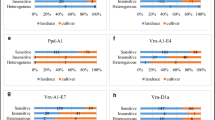Abstract
Hexaploid wheat has the largest cultivated area among crop plants due to its adaptability to different agroclimatic regions. A large part of this adaptability depends upon the variation in vernalisation and photoperiod requirements. A better understanding of the genetic control of flowering in wheat, as expressed by vernalisation requirements and photoperiod response, will guide breeders in targeting crosses of different types and will also improve our understanding of regional adaptation requirements. Characterisation of large numbers of breeding lines for photoperiod and vernalisation response in wheat is needed to assign the lines to geographic areas of most probable adaptation. Simple screening methods to quantify the effects of these two factors and their interaction are needed to assist breeding progress. Twenty wheat lines were evaluated for response to photoperiod and vernalisation under two controlled environments and under high ambient air temperatures in field conditions. Vernalised and non vernalised seedlings were transplanted into pots and placed in three photoperiod (8, 12 and 16 h light) cabinets, in the greenhouse or in growth chambers. Days to anthesis decreased with increasing length of photoperiod. Vernalised plants flowered earlier than non vernalised plants. There was a significant correlation between days to anthesis in the greenhouse and the growth chamber (r=0.88, P<0.001). Length of basal vegetative period, effects of vernalisation, and photoperiod from the two screening techniques were positively correlated with each other. Growth habit score, vernalisation requirement and heading date in the field were highly correlated with the main effect of vernalisation in the two controlled environments. The results indicated that selection for vernalisation response in a large number of genotypes can be achieved under high ambient air temperatures in the field. The selected material can subsequently be screened for photoperiod response under greenhouse conditions. Using these techniques, 49 local and improved cultivars from the Mediterranean region in west Asia and north Africa (WANA), showing differences in response to photoperiod, vernalisation, and earliness independent of vernalisation and photoperiod, affecting time to anthesis, were identified. Most old local cultivars were sensitive to both photoperiod and vernalisation. All the improved genotypes were insensitive to photoperiod. Responses to vernalisation were generally small under short photoperiods, but were more pronounced in long photoperiod, particularly in winter and facultative types from northern latitudes. These results should help to explain the adaptability of cultivars based on photoperiod and vernalisation requirements and their interaction.
Similar content being viewed by others
References
Appleton, R.J. & P.H.F. Haggar, 1985. Apical timed N could add precision to ADA recommendations. Arable Farming 12: 26–30.
Cao, W. & D.N. Moss, 1991. Vernalisation and phyllochron in winter wheat. Agron J 83: 178–179.
Ford, M.A., R.B. Austin, W.J. Angus & G.C.M. Sage, 1981. Relationship between the responses of spring wheat genotypes to temperature and photoperiodic treatment and their performance in the field. J Agric Sci Camb 96: 623–634.
Halloran, G.M., 1975. Genotype differences in photoperiodic sensitivity and vernalisation response in wheat. Ann Bot 39: 845–851.
Hunt, L.A., 1979. Photoperiodic responses of winter wheats from different climatic regions. J Plant Breeding 82: 70–80.
Masle, J., G. Doussinault & B. Sun, 1989. Response of wheat genotypes to temperature and photoperiod in natural conditions. Crop Sci 29: 712–721.
Midmore, D.J., 1980. Growth, development and yield of wheat (Triticum aestivum L.) in the tropics. Ph.D. Thesis, University of Reading, England. 96 pp.
Midmore, D.J., P.M. Cartwright & R.A. Fischer, 1982. Wheat in tropical environments. I. Phasic development and spike size. Field Crops Res 5: 185–200.
Ortiz Ferrara, G., S. Rajaram & M.G. Mosaad. 1994. Breeding strategies for improving wheat in heat-stressed environments. In: D.A. Saunders & G.P. Hettel (Eds.), Wheat in Heat-Stressed Environments: Irrigated, Dry Areas and Rice-Wheat Farming Systems, pp. 24–32. CIMMYT, Mexico, D.F., Mexico.
Penrose, L.D.J., R.H. Martin & C.F. Landers, 1991. Measurement of response to vernalisation in Australian wheats with winter habit. Euphytica 57: 9–17.
Pirasteh, B. & J.R. Welsh, 1980. Effect of temperature on the heading date of wheat cultivars under a lengthening photoperiod. Crop Sci 20: 453–456.
Qualset, C.O & Y.P. Puri, 1975. Heading time in a world collection of durum wheat: Photo-and thermal-sensitivity related to latitudinal responses and geographic origins. In: Proceedings of the Bari durum wheat symposium, pp. 165–178. Bari, Italy.
Author information
Authors and Affiliations
Rights and permissions
About this article
Cite this article
Ferrara, G.O., Mosaad, M., Mahalakshmi, V. et al. Photoperiod and vernalisation response of Mediterranean wheats, and implications for adaptation. Euphytica 100, 377–384 (1998). https://doi.org/10.1023/A:1018375616915
Issue Date:
DOI: https://doi.org/10.1023/A:1018375616915




